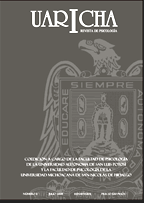The Torrance Creative Thinking Test and the school average of university students.
Main Article Content
Abstract
Se presentan resultados de la adaptación al español de una prueba de creatividad, el Test de Pensamiento Creativo de Torrance y su relación con el promedio de calificaciones escolares del ciclo inmediato anterior de un grupo de estudiantes universitarias. La tendencia general de las correlaciones entre los tests verbales y los tests gráficos no permite afirmar que exista una relación positiva entre los resultados del test y las medidas del aprovechamiento escolar. En este estudio las correlaciones entre los promedios de las calificaciones escolares y las puntuaciones estándar de la prueba son, en su mayor parte, negativas. Solamente para el caso del puntaje promedio de las pruebas verbales y la fluidez verbal específicamente, se observa una tendencia general de correlación positiva. Esto puede deberse entre múltiples factores, a que la muestra seleccionada está constituida por población estudiantil de una carrera que enfatiza las
habilidades verbales más que el „pensamiento gráfico‟. O bien, a la intelectualización excesiva en los estudiantes universitarios que actúa en detrimento de la creatividad, lo que explicaría el porqué la mayor parte de las correlaciones encontradas son negativas, principalmente la Resistencia al Cierre y la Fluidez Gráfica.
Article Details
Section

This work is licensed under a Creative Commons Attribution-NonCommercial-NoDerivatives 4.0 International License.
The authors have the right to ownership or copyright and they give to "Uaricha Psychology Magazine" the right to publish for the first time the article, as well as disclose and distribute it on the technological available media and through repositories.
Uaricha Psychology Magazine, is a quarterly publication, published by the Psychology College of the "Universidad Michoacana de San Nicolás de Hidalgo", Street Francisco Villa No. 450, Col. Dr. Miguel Silva, Morelia, Michoacán, P. C. 58110. Phone (+52) 443 312 9909, ext. 149, www.revistauaricha.umich.mx, uaricha.publicaciones@umich.mx. Responsible publisher: Roberto Oropeza Tena. Reserve of exclusive use rights No. 04-2013-070413365500-203, e-ISSN: 2007-7343, Granted by the National Institute Copyright. Responsible of the last update of this number, Computer center of the Psychology College, Ing. Erick Vidar Alva Rangel.
How to Cite
References
Anastasi, A. (1968). Tests Psicológicos. Madrid: Aguilar, (1976)
Beaudot, A. (1980) La Creatividad. Madrid: Narcea.
Guilford, J. P. (1950). Creativity. American Psychologist, 5 (9) Trad. Esp. En: A. Beaudot: La creatividad. (1980) Madrid: Narcea, 19-34.
Torrance, E. P. (artículo inédito) La validez predictiva de los tests de pensamiento creativo. En: A. Beaudot: La creatividad. (1980) Madrid: Narcea, 65-80.
Torrance, E. P. (1990) Torrance Tests of Creative Thinking: Manual for Scoring and Interpreting Results. Verbal Forms A and B. Bensenville, Ill: Scholastic Testing Service.Torrance, E. P., Ball, O. E. y Safter, H. T. (1992) Torrance Tests of Creative Thinking: Streamlined Scoring Guide Figural A and B. Bensenville, Ill: Scholastic Testing Service.
Torrance, E. P. (1998) Torrance Tests of Creative Thinking: Norms-Technical Manual Figural (Streamlined) Forms A & B. Bensenville, Ill: Scholastic Testing Service.

